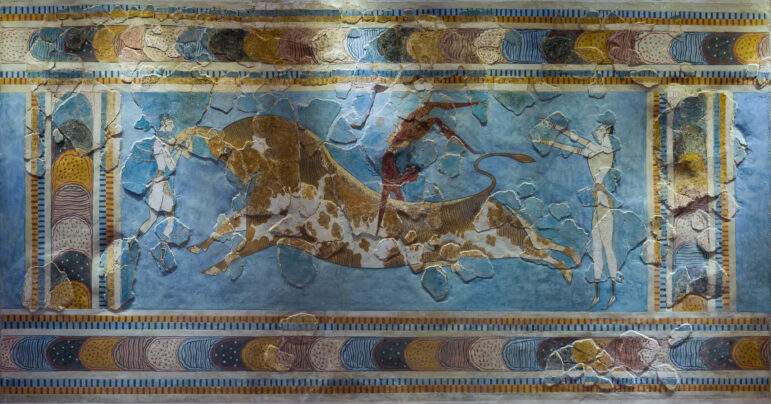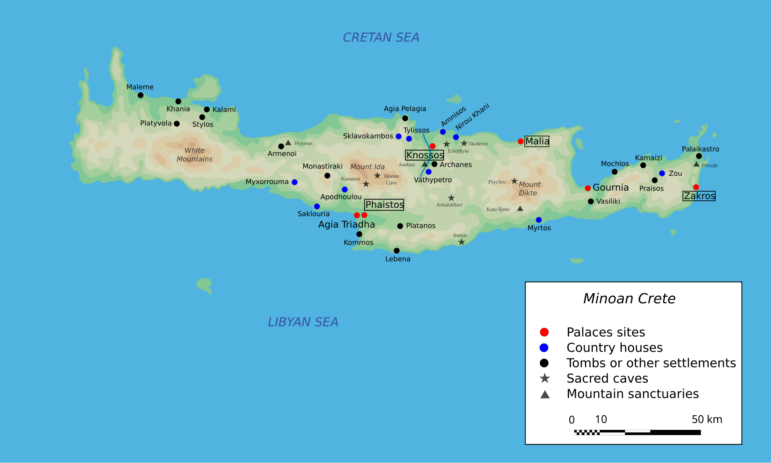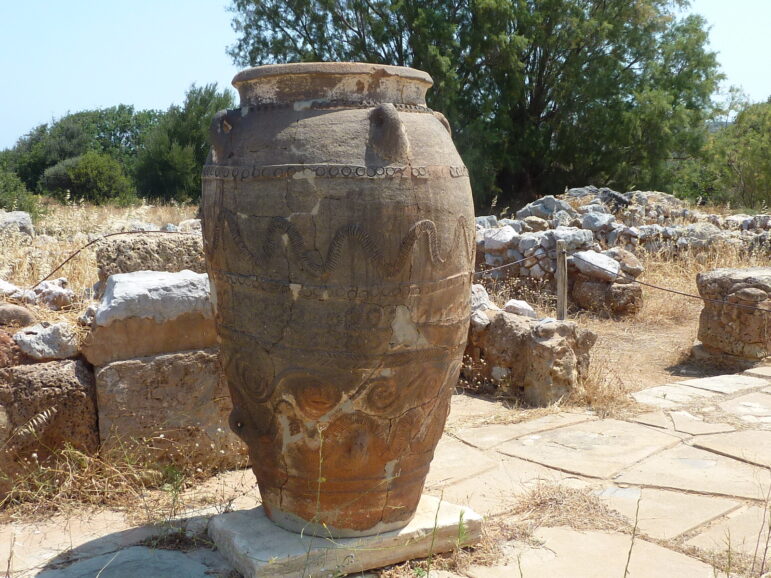ATHENS – In February 2024, Greek authorities completed the candidacy file for the inclusion of Crete’s ancient Minoan palaces on the United Nations Educational, Scientific and Cultural Organization’s World Heritage List. Being part of UNESCO’s programs, such as the World Heritage List, not only acknowledges the significance of these sites but also helps educate people worldwide about their importance. Furthermore, inclusion in UNESCO’s list promotes local economic development and channels financial support, expert advice, and resources for conservation efforts. This is especially crucial in regions where local governments may lack the means to maintain these sites independently.
The announcement marked a pivotal step in recognizing the global importance of Crete’s rich Minoan civilization, which flourished over 3,500 years ago.

The “Bull Leaping Fresco” from Knossos, now on display at the Heraklion Archeological Museum [public domain
The 2024 UNESCO candidacy file, submitted by Greece’s Ministry of Culture, features six ancient Minoan palaces: Knossos, Zakros, Phaistos, Malia, Zominthos, and Kydonia. These sites are key to understanding the Minoan civilization, an advanced society that dominated the Aegean during the Bronze Age. Knossos, the largest of the six, is especially renowned for its role as a cultural and administrative center. However, each palace provides unique insights into the Minoan world.
The UNESCO committee will assess the candidacy based on several criteria, including the preservation of the sites, their historical significance, and their cultural impact on a global scale. This nomination is part of Greece’s broader efforts to protect these ancient monuments and secure their place in global heritage.
Located about three kilometers east of modern Malia and near Potamos beach, the Malia Minoan Palace is the third-largest Minoan palace on Crete, after Knossos and Phaistos. According to mythology, Malia was ruled by Sarpedon, a brother of King Minos and a son of Zeus and Europa. Although the city’s original name is uncertain—Tarmaros or Milatos are possible candidates—Malia was undoubtedly a major urban center during the Minoan era.

Map of Minoan Crete [Credit: Bibi Saint-Pol CCA-SA 3.0
The Malia Minoan Palace is a significant archaeological site, rich in history, architectural achievements, and cultural importance. This article explores the discoveries made at Malia, its historical context, and ongoing efforts to preserve and promote the Minoan civilization. Built around 1900 BCE, the palace complex originally covered 8,800 square meters, reflecting the Minoans’ architectural skill. The two-story design was organized around a large rectangular courtyard, flanked by four wings. The west side of the palace contained important areas, including royal chambers, workshops, and storage rooms for essential goods like olive oil, grain, and wine. Giant earthenware jars, known as pithoi, some up to two meters tall, indicate the scale of storage and trade activities at Malia.

Archaeological finds from the Minoan palace in Malia [Credit: Majawik17 CCA-SA 4.0
One of the palace’s more enigmatic features is a kernos stone—a large millstone-like object with a cup attached. Its exact purpose remains debated, but it likely had religious or ceremonial significance. The site also features an advanced drainage system, designed to manage spills from storage rooms, showcasing the Minoans’ engineering expertise.
Despite its grandeur, the palace was destroyed around 1700 BCE, likely due to a devastating earthquake. It was rebuilt but suffered further destruction around 1450 BCE, possibly from another earthquake or invasion. The ruins visible today date mainly from this second phase of construction.
The existence of the Malia Minoan Palace remained unknown until around 1880 when a local landowner discovered gold sheets near the site. This prompted treasure hunters to explore the area, though systematic excavations did not begin until 1915. Led by Joseph Hatzidakis, these excavations unearthed significant artifacts, including the famous gold bee jewel, later uncovered by the French Archaeological School in 1921. This intricate piece of jewelry, now housed in the Heraklion Archaeological Museum, is a symbol of Minoan craftsmanship.
Excavations revealed that Malia’s layout covered about one square kilometer, with scattered neighborhoods surrounding the palace. The palace itself was organized around a central courtyard, likely used for ceremonial and administrative functions. One of the most important finds was a royal scepter, discovered in the weapons room, further underscoring the palace’s political and ceremonial significance.
Last month, a UNESCO delegation visited the Malia Minoan Palace as part of their evaluation of Crete’s Minoan palatial centers. This visit was one of several planned inspections as UNESCO considers adding these sites to its prestigious World Heritage List. If successful, this recognition would emphasize the global importance of Minoan civilization and bolster efforts to preserve and promote these ancient treasures.
The inclusion of the Minoan palaces on UNESCO’s list would not only raise awareness of their historical value but also boost tourism in Crete. Knossos, near Heraklion, is already one of Greece’s most popular tourist destinations, attracting thousands of visitors annually. Similarly, adding Malia to the UNESCO list would draw more global attention, encourage further archaeological research, and provide additional funding for conservation efforts.
The Region of Crete, local municipalities, and the Archaeology Department have already made efforts to improve conditions around these sites. Recent renovations at Knossos, for instance, have included restoring wooden walkways and enhancing accessibility. Malia has benefited from similar initiatives, improving the area to facilitate visitor access. However, challenges remain, such as parking issues during peak tourist seasons.
Malia’s significance extends beyond its architectural grandeur and political role. The palace offers a window into the daily life, religious practices, and economic activities of the Minoan people. Its strategic location on Crete’s north coast made it a key hub for trade, particularly with the East. The palace’s storage facilities, workshops, and ceremonial areas reflect the Minoans’ sophistication and their influence throughout the Eastern Mediterranean.
The artifacts discovered at Malia, from the royal scepter to the gold bee jewel, provide glimpses of the wealth and artistic achievements of the Minoan civilization. As UNESCO continues its evaluations, the Malia Minoan Palace stands as a testament to the enduring legacy of one of the world’s earliest and most influential cultures.
The Wild Hunt is not responsible for links to external content.
To join a conversation on this post:
Visit our The Wild Hunt subreddit! Point your favorite browser to https://www.reddit.com/r/The_Wild_Hunt_News/, then click “JOIN”. Make sure to click the bell, too, to be notified of new articles posted to our subreddit.